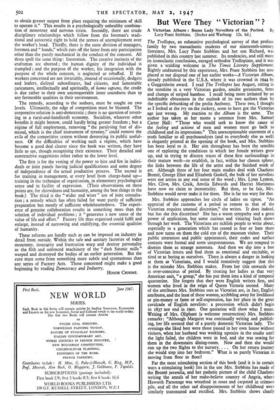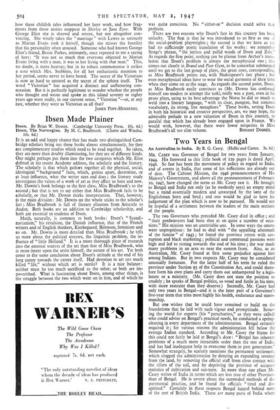But Were They " Victorian " ?
The Trollopes, an exhaustive psychological survey of that profuse family by two transatlantic students of our nineteenth-century literature, Mrs. Lucy Poate Stebbins and her son Richard, was published in this country last summer. Its tendencies, and still more its iconoclastic conclusions, enraged orthodox Trollopians, and it was given a • scalding welcome in The Times Literary Supplement. Rightly undaunted by this experience, Mrs. Poate Stebbins has now placed at our disposal one of her earlier works—A Victorian Album, already published in the U.S.A. where it was crowned in 5944 by a Guggenheim award. I read The Trollopes last August, sitting in the sunshine in a very Victorian garden, amidst geraniums, ferns and clumps of striped bamboo. I recall being more irritated by an indefinable obtuseness in the outlook of its two authors than by the specific debunking of the prolix Anthony. These two, I thought as I looked at the ivy on the rockery, seem to have got the Victorian age just wrong. My reaction to the Album is the same. The author has taken as her motto a sentence from Mrs. Samuel Carter Hall: " Those who would seek to know the cause of the feeling and actions of men and women must go back to childhood and its impressions." This unexceptionable statement of a truth familiar to all psychoanalysts (and to everybody else as well) is elegantly printed at the opening of the book, and Mrs. Stebbins has been loyal to it. Her aim throughout has been the sensible one of exploring the conditions in which her female writers grew up, and in trying to discern traces of these first surroundings in their mature work—to establish, in fact, within her chosen sphere, the links between the life of the artist and the finished work of art. Although three of her four main studies deal with Charlotte Bronte, George Eliot and Elizabeth Gaskell, the bulk of her novelists were not artists in any real sense of the word ; Mrs. Lynn Lynton, Mrs. Clive, Mrs. Craik, Amelia Edwards and Harriet Martineau have now no claim to immortality. But then, to be fair, Mrs. Stebbins would never make it for them. She is far too wary for that.
Mrs. Stebbins approaches her circle of ladies on tiptoe. "An appraisal of the customs of a period so remote as that of the Victorian requires unusual discretion," she writes. It does indeed, but has she this discretion? She has a warm sympathy and a great power of application, but some curious and vitiating fault shows Through her work. The Victorians are ticklish people to write about, especially to a generation which has ceased to fear or hate them and now turns on them the cold eye of the museum visitor. Their public utterances and public appearance's, their codes and surface contacts were formal and seem unspontaneous. We are tempted to dismiss them as strange automata. And then we dip into a box of Victorian letters and find them as emotional and excitable, as tired or as boring as ourselves. There. is always a danger in looking at them as Victorians, and I would tentatively suggest that this is the mistake Mrs. Stebbins makes. From her title onwards she is over-conscious of period. By treating her ladies as that very American unit, " a group," she has put them into a kind of temporal quarantine. She forgets that they were English writers first, and women who lived in the reign of Queen Victoria second. Many of the attributes Mrs. Stebbins sees as Victorian are, in fact, English attributes, and the least of these women, scribbling away for livelihood or pin-money or fame or self-expression, has her place in the great cavalcade of English novelists : a procession which didn't begin in 1837 nor end in 1901. One quotation will show what I mean. Writing of Mrs. Oliphant (a welcome resurrection) Mrs. Stebbins remarks: "Although Margaret was continually writing and publish- ing, her life seemed that of a purely domestic Victorian lady. The evenings she liked best were those passed in her own house without visitors, when her husband was working upstairs in the studio until the light failed, the children were in bed, and she was sewing for them in the downstairs dining-room. Now and then she would run up the two flights to the nursery. . . . On her return journey she would step into her bedroom." What is so purely Victorian in moving from floor to floor?
Far the most stimulating section of this book (and it is in certain ways a stimulating book) lies in the use Mrs. Stebbins has made of the Brontë juvenilia, and her pathetic picture of the child Charlotte writing the annals of her make-believe country of Angria, where Haworth Parsonage was wreathed in roses and carpeted in crimson pile, and all the other sad disappointments of her childhood were similarly transmuted and rectified. Mrs. Stebbins shows clearly how these childish tales influenced her later work, and how frag- ments from these stories reappear in Shirley or Jane Eyre. With George Eliot she is shrewd and severe, but not altogether con- vincing. She wisely takes the " marriage " with Lewes as seriously as Marian Evans took it herself, though she misses the hostility that his personality often aroused. Someone who had known George Eliot's friend, Bessie Parkes, intimately, once repeated to me a saying of hers : "It was• not so much that everyone objected to Marian Evans living with a man, it was to her living with that man." This, no doubt, is mere hearsay; but in its robust commonsense it strikes a note which Mrs. Stebbins, for all her enthusiastic attention to her period, seems never to have heard. The secret of the Victorians is now as hard to unravel as the secret of the sphinx itself. The word " Victorian " has acquired a distinct and unflattering con- notation. But it is perfectly legitimate to wonder whether the people who thought and wrote and spoke in this island seventy or eighty years ago were really, in our current sense, " Victorian "—or, at any rate, whether they were as Victorian as all that?
JAMES POPE-HENNESSY.



































 Previous page
Previous page